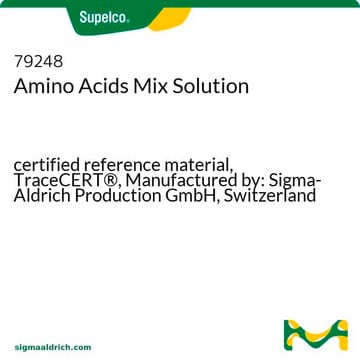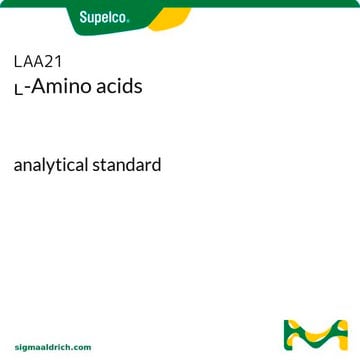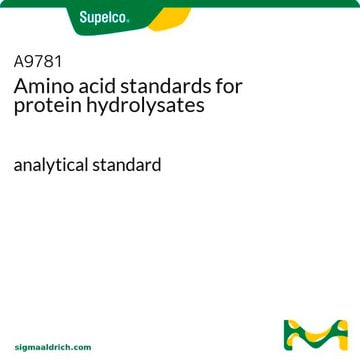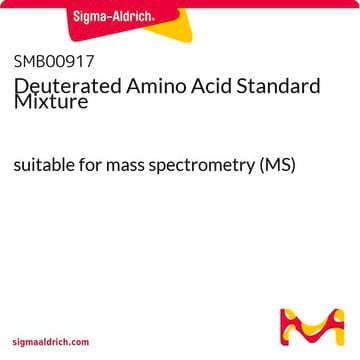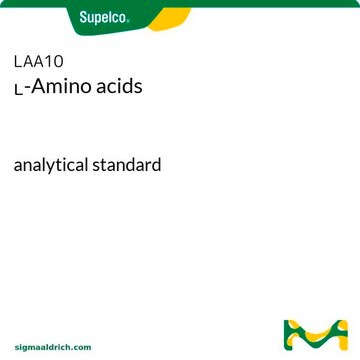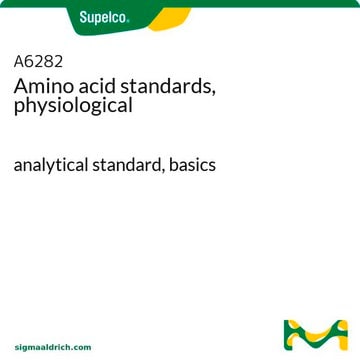No method is available to identify each of the peaks for this product. Contact the regional Technical Service group for assistance with identifying chromatographic peaks according to specific analytical techniques.
AAS18
Étalon d′acide aminé
analytical standard
About This Item
Produits recommandés
Qualité
analytical standard
Durée de conservation
limited shelf life, expiry date on the label
Classe(s) chimique(s) de l'analyte
amino acids, peptides, proteins
Technique(s)
HPLC: suitable
gas chromatography (GC): suitable
Application(s)
food and beverages
Format
multi-component solution
Température de stockage
2-8°C
Application
- dosage d'acides aminés L et D et de la glycine par chromatographie liquide et spectrométrie de masse en tandem (LC-MS/MS) après dérivatisation avec le réactif chiral de Marfey.
- analyse d'acides aminés par chromatographie liquide haute performance (HPLC) durant la caractérisation d'un concentrat de protéines de son de riz dégraissé pour évaluer sa capacité de liaison au fer.
- développement d'une méthode de chromatographie en phase gazeuse-spectrométrie de masse (GC-MS) pour la détermination du profil de 112 métabolites amino-carboxyliques dans des échantillons d'urine humaine en utilisant du chloroformiate de 1,1,1,2,2,3,3-heptafluorobutyle pour la dérivatisation et une micro-extraction liquide-liquide pour le traitement des échantillons.
- détection et quantification non énantiomériques d'acides aminés sous leurs différentes formes (libre, dissoute, particulaire, totale) dans des échantillons d'eau naturelle par HPLC couplée à une détection par fluorescence avec une colonne C18.
Conditionnement
Composants
- L-Alanine
- Chlorure d′ammonium
- L-Arginine
- Acide L-aspartique
- L-Cystine
- Acide L-glutamique
- Glycine
- L-Histidine
- L-Isoleucine
- L-Leucine
- L-Lysine
- L-Méthionine
- L-Phénylalanine
- L-Proline
- L-Sérine
- L-Thréonine
- L-Tyrosine
- L-Valine
Autres remarques
Produit(s) apparenté(s)
Mention d'avertissement
Warning
Mentions de danger
Conseils de prudence
Classification des risques
Met. Corr. 1
Code de la classe de stockage
8B - Non-combustible corrosive hazardous materials
Classe de danger pour l'eau (WGK)
nwg
Point d'éclair (°F)
Not applicable
Point d'éclair (°C)
Not applicable
Faites votre choix parmi les versions les plus récentes :
Certificats d'analyse (COA)
Vous ne trouvez pas la bonne version ?
Si vous avez besoin d'une version particulière, vous pouvez rechercher un certificat spécifique par le numéro de lot.
Déjà en possession de ce produit ?
Retrouvez la documentation relative aux produits que vous avez récemment achetés dans la Bibliothèque de documents.
-
Is there a recommended HPLC method and associated chromatogram to allow identification of each of the peaks and quantification of each amino acid in a sample (by retention time/integration)?
1 answer-
Helpful?
-
-
How is shipping temperature determined? And how is it related to the product storage temperature?
1 answer-
Products may be shipped at a different temperature than the recommended long-term storage temperature. If the product quality is sensitive to short-term exposure to conditions other than the recommended long-term storage, it will be shipped on wet or dry-ice. If the product quality is NOT affected by short-term exposure to conditions other than the recommended long-term storage, it will be shipped at ambient temperature. As shipping routes are configured for minimum transit times, shipping at ambient temperature helps control shipping costs for our customers. For more information, please refer to the Storage and Transport Conditions document: https://www.sigmaaldrich.com/deepweb/assets/sigmaaldrich/marketing/global/documents/316/622/storage-transport-conditions-mk.pdf
Helpful?
-
-
How can I determine the shelf life / expiration / retest date of this product?
1 answer-
If this product has an expiration or retest date, it will be shown on the Certificate of Analysis (COA, CofA). If there is no retest or expiration date listed on the product's COA, we do not have suitable stability data to determine a shelf life. For these products, the only date on the COA will be the release date; a retest, expiration, or use-by-date will not be displayed.
For all products, we recommend handling per defined conditions as printed in our product literature and website product descriptions. We recommend that products should be routinely inspected by customers to ensure they perform as expected.
For products without retest or expiration dates, our standard warranty of 1 year from the date of shipment is applicable.
For more information, please refer to the Product Dating Information document: https://www.sigmaaldrich.com/deepweb/assets/sigmaaldrich/marketing/global/documents/449/386/product-dating-information-mk.pdfHelpful?
-
-
What is the difference between AAS18 and 79248 (CRM)? What are the storage and shipping conditions? How does the quality of AAS18 compare to CRM?
1 answer-
AAS18 is stored at 2-8°C, while 79248 is stored at -20°C. Both are shipped at ambient temperature. Amino Acid 79248 is a CRM, Certified Reference Material, and AAS18 is a standard. AAS18 does not undergo the rigorous testing that is used for CRM standards.
Helpful?
-
-
Wie lange ist der AAS18 Aminosäuren Standard haltbar, wenn er bei Temperaturen von 2-8°C gelagert wird?
1 answer-
The expiration date of this product is listed on the lot-specific Certificate of Analysis.
Please access the link below to download a Certificate:
https://www.sigmaaldrich.com/product/sial/aas18#product-documentationHelpful?
-
Active Filters
Notre équipe de scientifiques dispose d'une expérience dans tous les secteurs de la recherche, notamment en sciences de la vie, science des matériaux, synthèse chimique, chromatographie, analyse et dans de nombreux autres domaines..
Contacter notre Service technique